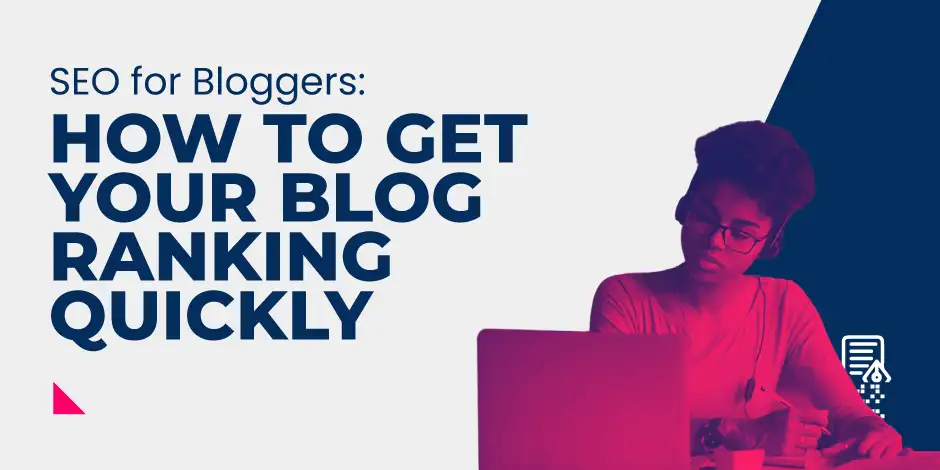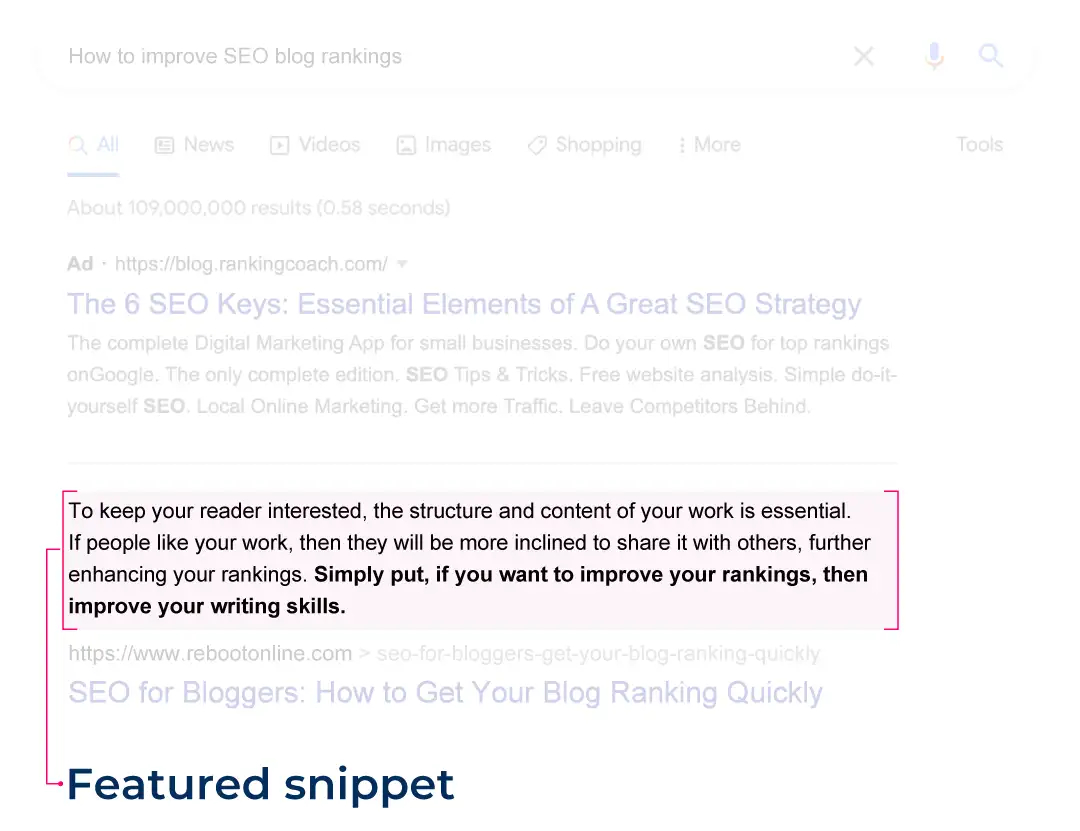
SEO Basics for Bloggers
With over 8.5 billion Google searches a day*, securing a good rank is not easy. However, doing so is well worth it. Recent SEO statistics show that the average return on investment (ROI) ratio of SEO is 22:1, meaning that for every £1 that you invest into your SEO strategy you could get £22 back. So, how do you get to that all-important top spot on the search engine results page (SERP)?
This is down to a number of different factors, but one of the most important is having a robust and rigorous search engine optimisation (SEO) strategy.
Many think that SEO is only relevant for businesses, but SEO experts will tell you differently; it is integral for bloggers too, especially if you wish to rank higher than your competitors.
To keep your reader interested, the structure and content of your work is essential. If people like your work, then they will be more inclined to share it with others, further enhancing your rankings.
Simply put, if you want to improve your rankings, then improve your writing skills.
Whether you are new to blogging, or a seasoned expert, blogging for business or blogging for pleasure, this guide will provide you with a range of helpful tips in order to boost your rankings on SERPs, and importantly, get more people visiting your blog.
What is SEO?

Broadly speaking, SEO is any activity that helps you to improve your ranking on search engines.
It is hard to know exactly what search engines are looking for when it comes to deciding on rankings - they are always tweaking their algorithms and changing the value they place on certain aspects of your website.
But there are generally agreed aspects that remain important to get right, in order to increase the likelihood of success.
At Reboot, have put together this guide of top 10 tips for effective SEO strategies and best practice for your blog, in order to rank as high, and as quickly, as possible on the SERPs.
By focusing your efforts on an effective SEO strategy, you will stay competitive and maintain a strong ranking over time.
Top 10 SEO tips for bloggers
1. Keyword research
Before you start putting fingers to keyboard, or pen to paper, it is imperative that you do keyword research.
If you are serious about dominating the search results, then you need to know which words your target audience actually searches for.
So, put yourself in the position of your intended audience, or even better create a user persona. Think about the user intent - what will they be searching for? What questions might they have on your given topic? What might their interests be?
These are all things you should do before publishing your blog. By doing this process of intent optimisation, you are optimising the content of your site to meet the expectation and needs of your searches, thus creating a better user experience.
2. Publish high-quality, relevant content
High-quality, relevant content is one of the most important factors in determining your search engine rankings.
Exclusive, user-friendly content written specifically for your intended target audience will increase traffic to your web pages, which improves the authority and relevance of your site. Google, and other search engines, will see this as an indicator that you are the ‘go to’ website for this type of content, and will rank you higher when other people search for similar content.
Your research of user intent will help with this, as well as giving you an idea of how much content is too much content for your particular topic.
There really is no substitute for great content when it comes to SEO.
3. Consider E-A-T
A web page that is rich in expert content, authoritative and trustworthy is more likely to attract links from other websites, which further enhances your SEO. This is known by the acronym E-A-T.

E-A-T is a framework developed by Google’s Search Quality Guidelines that helps the search engine to determine how useful, helpful and relevant a page is, in answering a user’s query. Therefore, websites with a higher E-A-T. tend to rank higher on the SERP.
According to Gary Illyes, a Google Webmaster Trends Analyst, E-A-T is largely based on links and mentions by authoritative sites. Google is very good at understanding which links count, so you should aim to include high-quality, relevant links over low-quality, irrelevant ones.
Updating your content regularly is crucial for demonstrating E-A-T and also making sure the information is factually correct - so definitely spend time proofreading and verifying any evidence you reference.
Any positive reviews you can get for your blog will further enhance your E-A-T, so make sure you broadcast the work you are doing on various social media channels to increase the chance of people finding, and reviewing, your blog.
If you have access to any experts or professionals in the field you are writing about, this will massively enhance the trustworthiness of your site, as these people will add credibility from their notoriety.
Plus, it is definitely worth flashing your credentials - show Google and your readers why you are an expert in what you are talking about. Whether it is your academic background, relevant awards you have won, conferences you have spoken at or publications you have been featured in, all of this will contribute to your credibility.
4. Optimise metadata (titles, keywords, descriptions and alt tags)
Optimising the metadata is very much the low-hanging fruit of an effective SEO strategy, but can often be easily overlooked.
Although metadata is important for SEO, it is not a direct ranking factor used in search engine algorithms. But there are indirect benefits which can result in higher rankings.
Your titles, keywords, descriptions and alt tags all provide vital information for web crawlers when trying to match your content to users’ search queries. So by making them fully optimised, it makes it easier for crawlers to find and match your information, increasing your chances of appearing towards the top of the SERP. 
Google, and other search engines, use click-through rate (CTR) as a way of working out whether your site is a good match for users’ search queries. The more people that click through to your site, the more relevant it is deemed, and therefore you would move up the rankings.
Seeing as over 25% of people click on the first Google result, why would you not want to be first? Especially when you consider that this number drops to 15% for the second result, and 2.5% for the tenth position. Let’s not even go onto the figures for page 2; if you are page 2 or higher, then you might as well not be on the Internet, as people are extremely unlikely to find you.
 Title
Title
Title metadata is the most important metadata on your web page. It is responsible for the page titles displayed at the top of the browser window, and as the headline within the SERP.
There are a number of things to consider when writing your meta titles, such as:
-
Keeping it as concise as possible
-
Using between 50-60 characters
-
Including your keyword(s) as close to the beginning of the title as possible
It is also good practice to end the title with the website name, for brand awareness purposes.
 Keywords
Keywords
Once you have undertaken your keyword research, and you are confident of what your intended users are likely to be searching for, then you can start implementing these into your content.
The key is to identify and target a specific keyword phrase for each authoritative content page on your blog. Make sure you include it in the webpage URL, once or twice in the opening paragraph and then scattered throughout the article.
Top tip: Don’t cram your keyword(s) into your content. This is known as keyword stuffing, and can actually have an adverse effect on your rankings if Google suspects you are trying to manipulate the crawlers to detect your content.
You can also use italics and bold to emphasise these keywords, as confirmed by Google’s John Mueller. He states that bolding information allows Google to understand the content better. However this is relative to the rest of the content on the page so use it sparingly - less is more!
Your language and writing style should flow and read naturally; never sacrifice good writing for the purpose of SEO.
The best content is written for people, not robots.
 Descriptions
Descriptions
The meta description appears below the title in the metadata. It is a snippet of information that summarises the content of the webpage.
There are a number of things to consider when writing your meta descriptions, such as:
- Keeping it as concise as possible
- Aiming to use two full sentences
- Using no more than 160 characters
- Encouraging users to click through to the site, so make it as compelling and persuasive as possible
- Including your keyword(s), but avoiding keyword stuffing and creating duplicate content.
Search engines may not always use your meta description, but it is important to give them the opportunity. If you do not include one, then they may generate one for you. The risk of this is that it may not accurately convey what your web page is about, which can then have a negative impact on your CTR rate and resulting ranking.
 Alt tags
Alt tags
Many of us think of search engines as a source of information, which they predominantly are. But considering that over 20% of the two trillion searches on Google are for images, this means there is a significant number of potential users that are not accessing your blog if you do not fully optimise your image alt tags.
Alt tags, also called alt text and alt descriptions, are the written copy that appears in place of an image on a webpage. This text helps screen-reading tools describe images to visually impaired users, and allows search engines to better crawl and rank your web page.
This will create a better user experience for your visitors, regardless of how they found you in the first place.
5. Optimise content for featured snippets
Featured snippets, also known as answer boxes, are short selections of content displayed on the SERP, without the user having to visit the page where the content is based.

Often called position zero, they are normally displayed above the organic SERP results, but below the paid advertisements in order to try and serve the user better.
You should have in mind questions that people might want the answers to, and formulate this into a clear, concise and succinct paragraph. Content between 54-58 words tends to work the best.
Alternatively, bullet or numbered lists that answer the searcher’s query are very effective (such as step-by-step instructions or where there are multiple, short answers to a question). Or you may opt for a short ‘how to’ video that users could watch to get their answers.
For non-question based keywords, you should adopt a definition style approach.
6. Use internal and external links
You can improve the authority and credibility of your website by adding relevant links within the text, which will help your users to access further information on the topic, should they wish to do so.
These links can either be internal (to other parts of your blog/website) or external (to other websites).

Internal links are extremely helpful both to your readers and search engines.
For your readers, it will help them to navigate your site, and point them to other content they may be interested in. It also keeps them on your website longer, and engaged with your material.
For search engines, it will help them to manage your content and understand relationships between different parts of your site. This increases the visibility of your site and helps to display a higher level of authority which, as previously discussed, is a ranking factor.
Top tip: You should always aim to use descriptive links by linking your keywords - not only does this improve your SEO, but also adds more value to your readers, particularly those with disabilities or who use screen readers.
External links also remain a strong ranking factor and good practice for SEO. It sends trackable traffic and can make your site more valuable for your users. By ensuring you link to high-quality sites, such as those with trust and value, then you are more than likely to be included in that same category.
So definitely spend the time linking to existing content as well as relevant, outside content that supports your writing and gives it credibility.
7. Update content regularly and target evergreen content where possible
You have probably noticed by now, the emphasis that we put on the quality of your content. But the frequency of which you add new posts can be a determining factor in your overall ranking.
By regularly adding new content, this tells Google that your website is alive. If your site is not active, then Google will crawl it less often, which can negatively impact your ranking.
BUT… do not just post for the sake of it; your content still needs to remain high-quality, informative, relevant and in line with your user intent.
Keeping your content up-to-date is viewed by search engines as an indicator of relevancy. So, keep your content as fresh as possible. It would be best practice to audit your content on a set schedule to make sure that updates are done consistently and systematically across your blog.
Top tip: Consider optimising older blog posts by promoting them on social media, tracking your search ranking and adding internal links to new content (this will help revamp older content, create more link juice and allow users to discover it more easily).
Your content should also be as evergreen as possible. By this, we mean content that remains relevant, regardless of the date or time of year. For example, a ‘2015 guide for the best TVs’ is probably not going to be relevant or trustworthy beyond 2015, as the industry would have changed, and new technologies and products would have since joined the market.
In terms of ranking, evergreen refers to content that will never lose residual traffic over time. Therefore, it is best to target content that doesn’t have an expiry date and can’t become obsolete. As a result, a better idea for the above example might be, “how to choose the best TV for you”.
8. Analyse your competitors’ websites and link profiles
What you are doing online, and the steps you are taking to improve your SEO strategy, is obviously vital if you are to rank as high as possible, as quickly as possible. However, just paying attention to your own practices might not be enough.
Taking a look at your competitors' websites can give you a peek behind the curtain to see what they are doing, which in turn can give you ideas for your blog.
Firstly, determine who your competitors are (based on your keyword and search engine result analysis).
Next, you should search their backlink profile. This can be done using a range of online tools; some of them are free (such as Open Link Profiler and Backlink Watch) and some are not (such as Moz’s Open Link Explorer and Ahrefs) - but remember, you get what you pay for!
The backlink profile will enable you to see behind the scenes of their marketing strategy, the backlinks they are receiving and who they are reaching out to.
This will allow you to assess the landscape you are competing on, and enables you to be more innovative in how you navigate it. You can capitalise on your competitors’ weaknesses, as well as develop new branding and marketing ideas for your blog.
Top tip: Look at what your competitors are doing to glean ideas, but also look at what they are not doing - can you identify a gap in the market to exploit, to give your site that competitive edge?
All of this will, in turn, allow you to better analyse your own website. Whether it is disavowing spammy sites you didn't know were there, or improving your use of anchor text, this will allow you to clean up your site and soar up through the rankings.
9. Optimise your blog’s speed and user experience
User experience (UX) is king when it comes to SEO. There is nothing more frustrating as a user to come across a blog that is hard to engage with, visually unappealing and sluggish to load.

Dwell time is an indirect ranking factor for search engines. This is the amount of time a reader spends on your webpage, from the moment they click on your site in the SERP, to the moment they exit. This metric indirectly tells the search engine how valuable your content is, as in theory, the longer a user spends on your page, the more relevant it is to their needs.
But this is a highly subjective measure - your blog could contain short content that only takes a minute to read. Or, all of the most relevant information might be at the start of the blog, which gives the reader the best user experience possible.
So you should aim to include material that aligns with your content strategy; do not aim to manipulate this purely to increase the dwell time as this could backfire.
Page speed is another factor that can impact a user’s experience of your site.
The visual elements of your blog, such as videos, images and data visualisations, can affect page speed. So be strategic about how often you use these; your blog needs to be aesthetically appealing and engaging, but overdoing it could have the opposite effect.
Top tip: Keep file sizes as low as possible and limit the number of videos you embed on a single page.
In addition, the use of HTML codes is essential to improving your content. However, unnecessary code can slow your site down, so aim to remove junk code to improve your page’s loading speed. You can use a HTML cleaner that requires no coding knowledge and does all of the hard work for you.
Overuse of plugins can also contribute to reduced loading speed. We recommend doing an audit of your plugins, and deciding on which ones you really need and which ones are now obsolete. Generally speaking, plugins that affect the front end of your site will have a greater impact on its speed, so start with these first.
Finally, optimising your website for mobile users is an excellent way of ensuring a better UX for your visitors.
Almost 60% of website traffic now comes from a mobile device, so optimising your blog for mobile will affect your SEO metrics. This can be achieved by using a responsive design, allowing your blog pages to have just one URL instead of two. This will help your SEO strategy as any inbound links that come back to your site won’t be divided into separate URLs. This will make it easier for search engines to recognise your posts and rank accordingly.
Top tip: Keep it simple with regards to font, structure and the use of images - and remember to add a call to action (CTA) to help with your conversion rate and entice the user onto the next step of their journey through your blog.
Ultimately, you want to create a blog where the users get the information they desire as quickly as possible, with minimal disruption and in an engaging way that makes them want to come back for more.
10. Review your content’s performance regularly to find new opportunities
As with any website, it is important to monitor online performance, in order to determine what is working well, what isn’t and explore new opportunities to develop further. And blogs are no exception to this.
Google has a free Search Console which contains a search analytics report. This can provide a range of useful data, including which keywords people are using to find your blog, what they are clicking on when they arrive and how your backlinks are performing.
Importantly, analytics tools like this allow you to see how Google views your site, and can give you a number of performance indicators such as referring domains, mobile site performance and high traffic queries/pages.
This will allow you to target specific areas of your blog to try and improve, as well as monitor the behaviour of your target audience, so that you can keep up to date with their changing habits and preferences.
To conclude
If you are serious about ranking as high as possible, and as quickly as possible, then you need to have a robust and rigorous SEO strategy.
The top 10 tips provided are by no means an exhaustive list, but provide a framework for which you, as a blogger, can utilise your SEO strategy to its advantage and put yourself in the best possible position in the SERP.
And the great thing about it, is that it is possible to teach yourself SEO.
But these things do not happen overnight; it is a long term process. They take careful consideration, time, planning and patience. By putting the effort into this from the beginning, you will reap the rewards in the future. Once you start seeing success, this will in turn lead to more success, and it is this snowballing effect that will help you to soar through the rankings to the dizzy heights of the results page.
If you want definitions of any SEO terminology, then click here to access our SEO dictionary.
* This figure is based on a calculation - with 98,650 Google searches per second and 86,400 seconds in a day. By multiplying the two numbers together, you get 8,523,360,000.
Originally written by Victoria Affleck in 2018, and updated for 2022 by Sean Rainforth.
